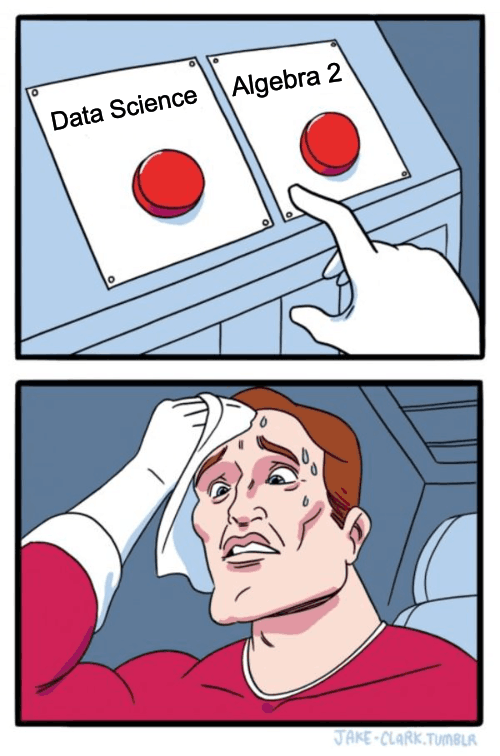
The national debate over Data Science and Algebra 2 present these subjects as conflicting alternatives. In fact, this is a conflict without a cause: the two subjects are in deep harmony. Understanding this is critical for this important policy debate.
 Five years ago, we predicted that standalone Data Science classes would compete for time against other standalone classes. We also feared that people would use Data Science to usurp existing math credits, without replicating the rigor contained in those classes. Unfortunately, the prediction became true in exactly the way we feared: Algebra 2 has become the sacrificial lamb to make room for Data Science. Prominent figures are pushing for Data Science classes to count for the same high school (HS) math credit as Algebra 2 — positioning one as an alternative to the other.
Five years ago, we predicted that standalone Data Science classes would compete for time against other standalone classes. We also feared that people would use Data Science to usurp existing math credits, without replicating the rigor contained in those classes. Unfortunately, the prediction became true in exactly the way we feared: Algebra 2 has become the sacrificial lamb to make room for Data Science. Prominent figures are pushing for Data Science classes to count for the same high school (HS) math credit as Algebra 2 — positioning one as an alternative to the other.
Enter the law of unintended consquences: if there's a class that doesn't have to include the more challenging parts of Algebra 2, and can be taken instead of Algebra 2, it would sadly be advantageous to create un-rigorous Data Science classes for the most vulnerable learners, a perverse incentive arising from the pressure to improve pass rates. Indeed, some Data Science courses are little more than old-fashioned spreadsheets classes. Should those count as HS math credit? Will they actually satisfy college entrance requirements? This has led to a debacle in California that made national headlines, and is causing serious unease in state departments of education across the country. Meanwhile, major universities who were initially supportive of this reform rushed to scrub Data Science from their admissions pages once they saw the lack of mathematical rigor.
Numerous states are asking the same question: what math should be included in Data Science in order to count as an alternative to Algebra 2?
Fortunately, there's an authority we can look to for an answer: the National Council of Teachers of Mathematics (NCTM), the nation's largest professional organization of math teachers whose position papers and statements carry enormous weight in the field. This Spring, NCTM President Kevin Dykema gave his answer: In order to be an alternative to Algebra 2, a Data Science class must teach quadratic, exponential, and logarithmic relationships.
This isn't coming from a politician, a trendy thought leader, or a silicon valley ed-reformer - this is coming from the head of one of the world's largest professional organizations of math teachers.
It's not hard to imagine how this might work. As just one example, the world spent the last few years living inside a non-linear word problem, staring at exponential infection rates and reading slogans like "flatten the curve!" Never in human history has there been a generation-defining event that so clearly illustrates the harmony between Data Science and Algebra 2. Everything from fuel efficiency to athletic performance to wildfire spread are best modeled using these relationships. Yet none of the big players in K-12 Data Science who are seeking Algebra 2 credit actually cover non-linear relationships!
In short, this policy debacle masks the fact that this is a false choice. Algebra 2's core material — such as quadratic, exponential, and logarithmic relationships — is actually central to data science, as every practicing data scientist knows. Thus, Algebra 2 enables data science, and data science can motivate Algebra 2.
This May, in partnership with DESE and EDC, we piloted explorations in Data Science that explicitly teach quadratics, exponents, and logarithmic relationships. Students use these concepts to make sense of patterns they see in data, and combine their lived experience and natural interests with algebra and statistics in order to draw their own conclusions and communicate their findings. This builds on several years of experience we have with modeling instruction in the context of Physics.
We still have a long way to go, but we're encouraged by what we've heard from the educators in this cohort, and can't wait to publish the materials for all to use. These lessons teach the core content familiar to any Algebra 2 teacher, but in ways that leverage relevant, real-world data to build curiosity and sense-making for students. This gives schools a choice of two compelling avenues to adding Data Science while keeping critical Algebra 2 content:
While the materials are not yet public, we're offering a sneak-peek! In August of 2023, we will run the nation's first "Data Science in Algebra 2" professional development for teachers. While this workshop is primarily targeted at Massachusetts teachers as part of our continuing work with DESE and EDC, there are a limited number of spots available for out-of-state educators who are able to pay for their own travel. If you or a colleague would like to join us, you can register here!
By enriching Data Science classes with nonlinear relationships and modernizing Algebra 2 classes with Data Science, we're putting a stake in the ground and standing against the false dichotomy that pits one against the other. And whether you're in a position to support alternative math pathways or not, these materials offer you two ways to have your cake — and eat it, too.